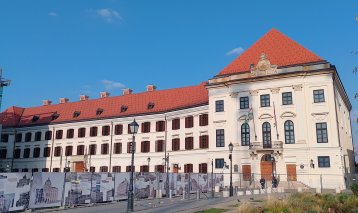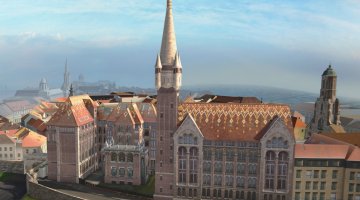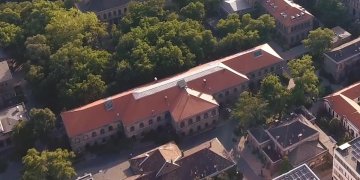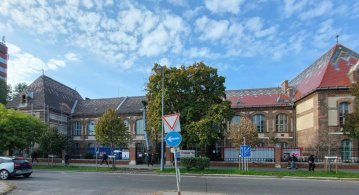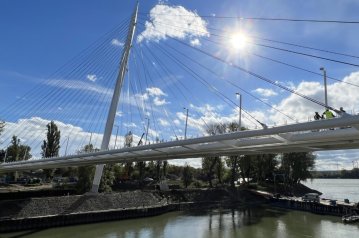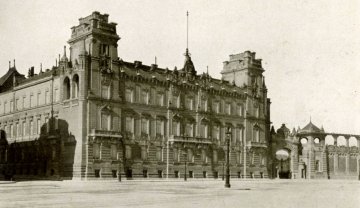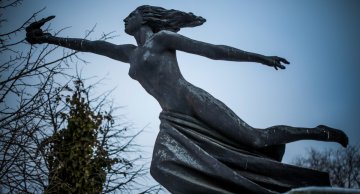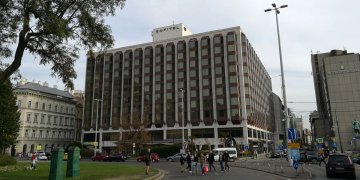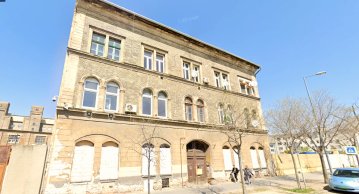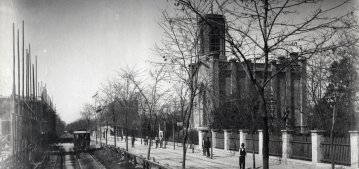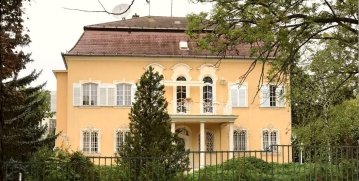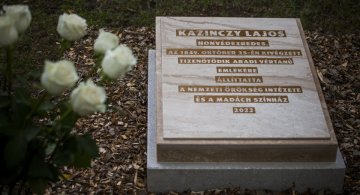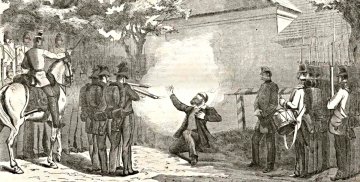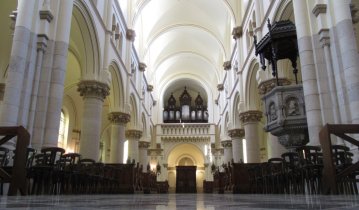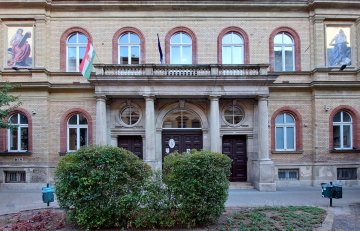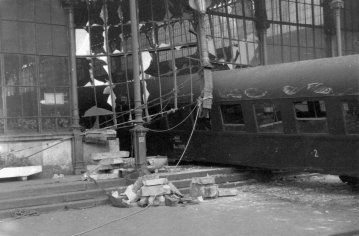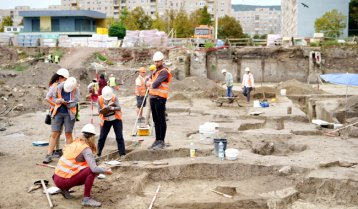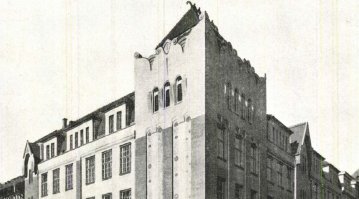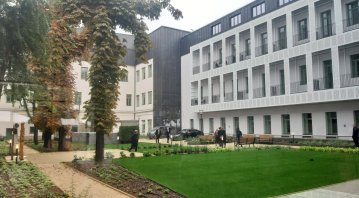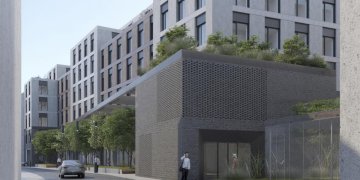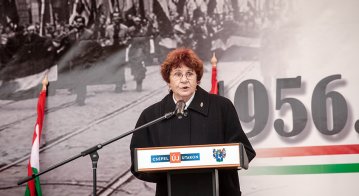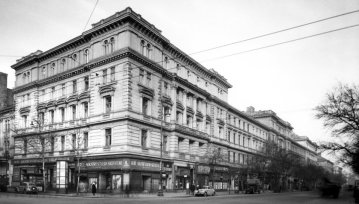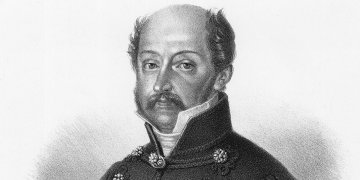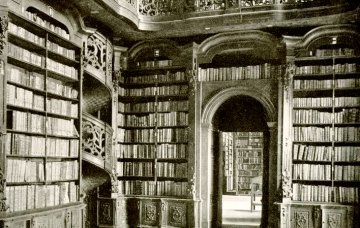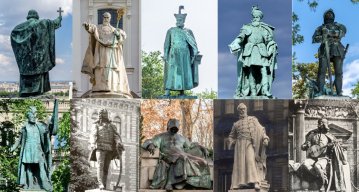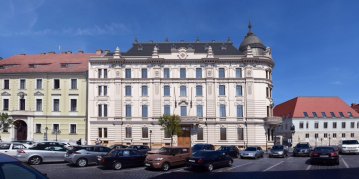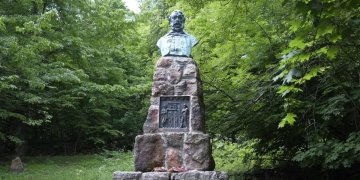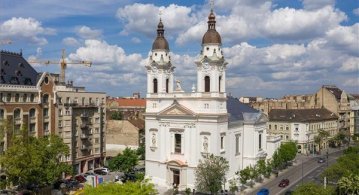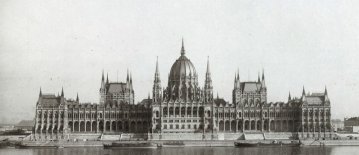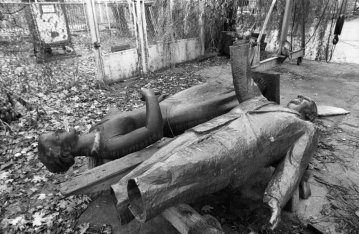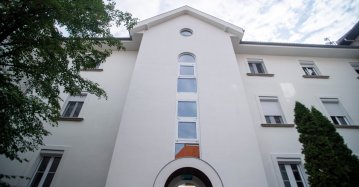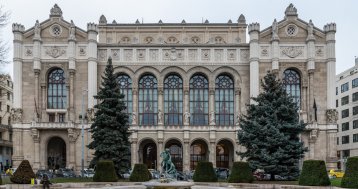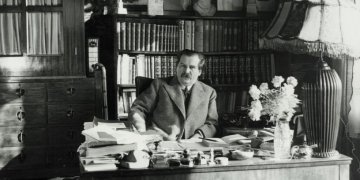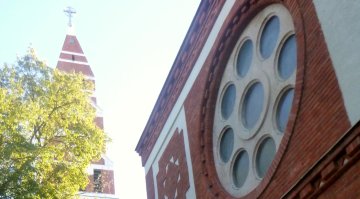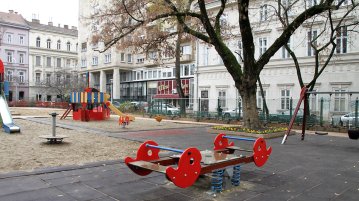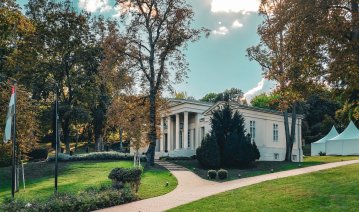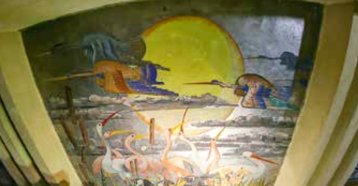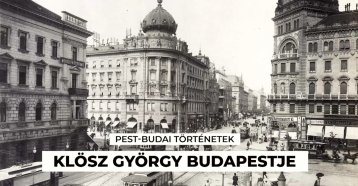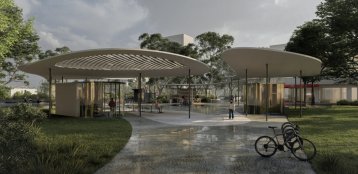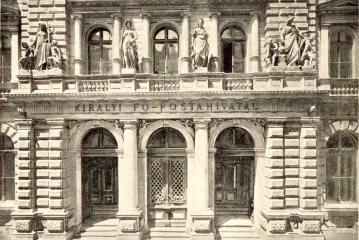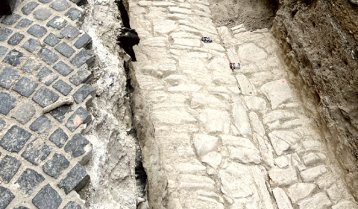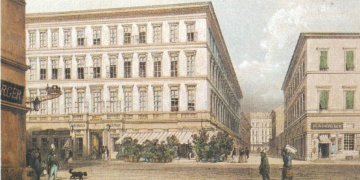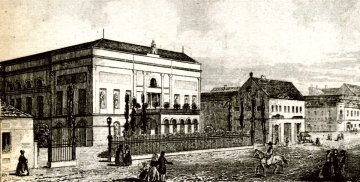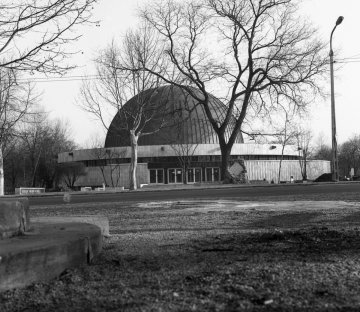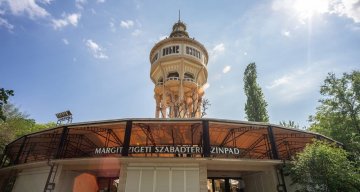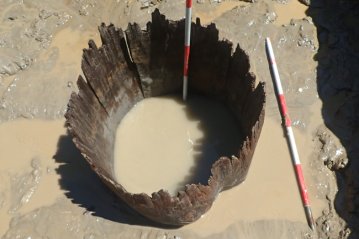 The Bridge Report, which brought a turning point in the history of Budapest
A travel report that changed the history of Pest and Buda, as well as Hungary. The little book contributed to the change of half a thousand years of legal customs and the implementation of an investment of unprecedented size and technical quality. This book was The Bridge Report [Hídjelentés in Hungarian].
The Bridge Report, which brought a turning point in the history of Budapest
A travel report that changed the history of Pest and Buda, as well as Hungary. The little book contributed to the change of half a thousand years of legal customs and the implementation of an investment of unprecedented size and technical quality. This book was The Bridge Report [Hídjelentés in Hungarian].
Search result
The foundation stone of the synagogue in Újlak was laid 135 years ago
October 16, 2022 at 2:00 PM
When the synagogue on Frankel Leó Road - then Zsigmond Street - was built, it was referred to as the Jewish church in Újlak. Its designer was Sándor Fellner, the creator of the Ministry of Finance in Buda Castle. The synagogue in the 2nd District is no longer seen as it was at the time of its construction since it has since been surrounded by a residential building.
The church and monastery were turned into a place of entertainment - the Castle Theatre opened 235 years ago
October 16, 2022 at 9:00 AM
One of the characteristic buildings of the Buda Castle is the Carmelite monastery, which has been used by the Prime Minister's Office for almost four years. The eponymous order of monks was actually forced to withdraw from the walls a long time ago, precisely 235 years ago, their church was turned into Castle Theatre. The ruthless intervention also greatly affected the building itself, but it was mostly then that the image that is known today was formed.
The renovation and expansion of the Hungarian National Archives are delayed
October 15, 2022 at 5:00 PM
The public procurement call for the construction of the headquarters of the Hungarian National Archives has been withdrawn, so it is not yet known when the renovation of the Bécsi Kapu Square building, the appropriate expansion of Samu Pecz's original plans and the rebuilding of its iconic tower, which was demolished after the war, can begin.
The renovation of the Neo-Renaissance building complex of the University of Veterinary Medicine begins
October 14, 2022 at 7:00 PM
The development of the István Street campus of the University of Veterinary Medicine will begin soon. Several of the buildings on the campus, designed by Imre Steindl, will be renovated. Buildings with a patina are modernised, and their interiors and facades are renovated while preserving historic values.
The roof structure of the University of Technology monument building is being renovated
October 14, 2022 at 1:00 PM
Scaffolding has already been erected for the Danube-bank monument building of the Faculty of Mechanical Engineering of the University of Technology, and the renovation has begun. The two-story building designed by Samu Pecz is located south of the central headquarters of the university. The reconstruction of the roof on the northern side of the building was already completed, and now the restoration work has started on the other side as well.
The footbridge connecting Csepel to Pest is structurally ready
October 13, 2022 at 5:30 PM
The Robinson Bridge, which connects Csepel with the Pest side, starting from the Ferencváros athletics stadium, is already structure-ready.
Archaeologists also found a silver denarius of King Matthias during the reconstruction of Archduke Joseph's palace
October 13, 2022 at 2:00 PM
During the construction of the reborn Archduke Joseph's palace on Buda Castle's Szent György Square, the archaeological excavation brought several special features to the surface: the specialists found an almost intact copper jug from the Turkish era, a silver denarius of King Matthias, and valuable ceramic and glass materials. They also found the passage that led to a cellar created from a natural rock cave. The room was probably used in the Middle Ages.
More works of art can be seen in the Fiumei Road Cemetery
October 12, 2022 at 3:30 PM
In the Fiumei Road Cemetery, a description of new tombstones of significant artistic value and their creator can be read with the help of a QR code. The statue of Andor Miklós' mausoleum and the tomb of Béla Pállik are among the twenty monument descriptions that have just been included in the institution's Sculpture Park program.
The hotel on the site of the former Lloyd Palace is being rebuilt
October 12, 2022 at 9:00 AM
Due to the ravages of World War II, Pest's Danube Promenade lost its former unique atmosphere. Modern hotels have been built in place of the old row of palaces, and the Atrium Hyatt has stood on the site of the destroyed Lloyd Palace since 1982, which today bears the name Sofitel. The hotel will soon receive a new facade, the building permit became final at the beginning of October. It can be read in the permit that the building will get a new level. Design renders have not yet been released.
House demolitions in the capital
October 11, 2022 at 5:30 PM
Several demolition permit procedures have been initiated in Budapest in recent months, which affect the historic part of the city or other interior areas important from a cityscape point of view. Pestbuda has selected from these.
A romantic jewellery box in Zugló - The construction of the Hermine Chapel began 180 years ago
October 10, 2022 at 5:00 PM
One of the typical buildings on Hermina Road, which marks the eastern border of City Park, is the small Hermina Chapel. Despite its size, it has a very decisive role, as not only the road was named after it, but also the district where it stands: Herminamező. In keeping with its style, its story is also romantic, containing both beauty and tragedy. The foundation stone of the small chapel was laid just one hundred and eighty years ago.
The state-owned villa in Vérhalom Square, where Árpád Göncz lived, was auctioned
October 10, 2022 at 2:00 PM
The two-story villa at 7B Vérhalom Square in the 2nd District, where the former President of the Republic, Árpád Göncz and his wife lived, was sold for 833 million HUF. Bidding at the online auction of Hungarian National Asset Management Inc. ended late on Saturday, and the winner offered several hundred million forints more than the asking price.
The memorial site of the 15th martyr of Arad, Lajos Kazinczy, was inaugurated in the Fiumei Road Cemetery
October 6, 2022 at 2:00 PM
The National Heritage Institute and the Madách Theatre set up a memorial in honour of the fifteenth Arad martyr, Lajos Kazinczy, in the Fiumei Road Cemetery. The son of the language reformer Ferenc Kazinczy was executed on 25 October 1849 in Arad. The parcel of the soldiers who died in the 1848-49 War of Independence can be found in the Fiumei Road Cemetery, as well as the tombstones of three Arad widows.
The Pest stations of a life: A tragic fate that befell Lajos Batthyány
October 6, 2022 at 10:00 AM
On 6 October, Hungarians remember not only the 13 generals of the army executed in Arad, but also Count Lajos Batthyány, the martyred Prime Minister of Hungary's first responsible government, who was executed in Pest, in the courtyard of the New Building. An eternal flame has stood at the place of the execution since 1926, a worthy memorial to the count, who gave his life for Hungarian freedom. Batthyány, who became the leader of the opposition during the reform era, moved to Pest in 1841, visited many notable places in the capital, and Pestbuda now collected these on the tragic anniversary.
The Bakáts Square Church designed by Miklós Ybl has been completed
October 5, 2022 at 6:30 PM
The renovation of the Bakáts Square Church in Ferencváros has been completed. With the expansion of the crypt, a new urn burial section was created, the church received a new floor covering, the plaster was restored and restoration work was carried out. The new altar was also consecrated at the weekend.
Imre Madách Secondary School moved into its current home 130 years ago
October 5, 2022 at 11:00 AM
In September 1892, the 7th District State Secondary School, i.e., today's Imre Madách Secondary School, welcomed not only the new academic year but also its new home. The institution, founded in 1881, did not have its own building for more than 10 years, teaching took place on rented premises. The Minister of Religion and Public Education in charge of educational affairs, Ágoston Trefort, commissioned the architect János Bobula Sr. to prepare the plans for the secondary school. But Trefort passed away in the meantime, and the new minister had other ideas about the school building.
A railway carriage got out of control and ended up on the Outer Ring Road
October 4, 2022 at 10:30 AM
Sixty years ago, on 4 October 1962, a railway carriage tore through the buffer stop of the main hall of the Nyugati (Western) Railway Station, breaking through the glass wall and running onto the Outer Ring Road. The accident was caused by human error, but thanks to the presence of mind of a railwayman, there was no mass catastrophe.
A drainage ditch system of Bronze Age origin was found in the area of Buszesz in Óbuda
October 3, 2022 at 6:30 PM
During the archaeological excavation in the area of the former distillery, Buszesz, a drainage protection structure of prehistoric origin was identified under the Roman layers in Óbuda. The ditch system ensured flood protection. Pile holes, storage and waste pits belonging to former buildings were also found.
110-year-old neighbours - The twins of the big school building campaign
October 3, 2022 at 2:00 PM
Fortunately, there are many architecturally valuable school buildings in Budapest. A significant part of them was created in a very short period, in just three years: the Capital implemented a large school building program between 1909 and 1912. Many well-known alma maters were born at this time, but Pestbuda now presents two less famous examples of this fertile era.
The burned-down but now rebuilt dormitory on Ráday Street was handed over
October 2, 2022 at 3:00 PM
In 2019, the Reformed dormitory in the 9th District, on the plot of the Dunamellék Reformed Church District bordered by Ráday Street, Köztelek Street, Markusovszky Square, and Biblia Street, burned down under tragic circumstances. In its place, on the side facing Markusovszky Square, the new dormitory wing has now been completed, but in addition, the central building bordered by Ráday Street and Köztelek Street, acquired in 1912, has also been completely remodelled. In the renewed headquarters building, the bishop's office can be found at 28 Ráday Street and the Faculty of Theology of the Károli Gáspár University of the Reformed Church can be approached from Köztelek Street.
It was once a steam bath, now a hotel is being built on Kazinczy Street
September 30, 2022 at 10:00 AM
At 40-48 Kazinczy Street in the 7th District, the area on which a 270-room hotel with a two-story underground garage can now be built was created by combining five lots. As part of the works, a section of the street will also be renovated, and the buildings currently standing on the lots will be demolished, so it is expected that the former steel-and-glass block of the Hungarian Dance Academy and the historicising house at 48, known first as a meat factory and then as a nightclub, will also be torn down.
A park will be named after Mária Wittner in Csepel
September 30, 2022 at 9:00 AM
The renewed park on the site of the former Görgey school in Csepel will be named after the revolutionist, Mária Wittner, who was sentenced to death in 1956, and an honorary citizen of the 21st District.
Even the economic crisis could not stop construction – The first Neo-Renaissance houses on Andrássy Avenue
September 29, 2022 at 11:00 AM
Similar to the last few crisis-filled years, there were also economic difficulties in the past centuries, which also had an impact on the construction industry. Such was the crisis of 1873, which very sensitively affected the mega-investment of the era, the constructions along Andrássy Avenue. Fortunately, construction began here as early as 1872 - i.e., 150 years ago - and some residential houses were soon completed, setting a good example for further construction.
The Pest audience adored his love poems - Sándor Kisfaludy was born 250 years ago
September 27, 2022 at 11:00 AM
Sándor Kisfaludy's first volume, Himfy szerelmei - A kesergő szerelem [Himfy's Loves - The Bitter Love], published in Buda in 1801, was a worthy opening of 19th-century Hungarian literature. Kisfaludy, who described his passionate love life in lyrical form, became an influential scientist and writer at a young age and was elected a member of the Hungarian Society of Scientists and the Kisfaludy Society. With his support, his brother Károly Kisfaludy published his famous yearbook, Aurora, which promoted Hungarian literature. Sándor Kisfaludy was born 250 years ago today.
The National Széchényi Library was founded 220 years ago
September 26, 2022 at 3:30 PM
After the foundation of the National Library 220 years ago, the donation of Count Ferenc Széchényi wandered for more than forty years, until it moved to its permanent place, the Hungarian National Museum. Later, the collection had to go from here as well, now Pestbuda will present the different locations in Pest.
The gift of the King: the legend of the ten statues
September 25, 2022 at 3:30 PM
It has been 125 years since Franz Joseph gave ten statues to Budapest on 25 September 1897. Most of the statues are still elegant decorations of the city to this day, and Pestbuda reported about them several times. However, we have now looked into what could have prompted Franz Joseph to give a gift.
The former headquarters of the Red Cross Society will soon show its original appearance
September 24, 2022 at 9:00 AM
The reconstruction of the building in Buda, originally designed by Alajos Hauszmann and Dezső Hültl, began in 2021, and recently the structural construction work was completed, so in addition to the construction of the roof and facade, the interior work will start in the autumn. With the reconstruction of the house at 1-2 Dísz Square, a wound in the cityscape that has been open for more than seventy years will be healed.
Lajos Kossuth's first public statue in Budapest - Special creation in the Zugliget Forest
September 21, 2022 at 11:00 AM
Few people know that at the end of Mátyás Király Road in Zugliget, in the forest, there is a special, 110-year-old statue of Kossuth on a huge pedestal. On the 220th anniversary of the former reformist politician's birth, Pestbuda will show the exact circumstances under which the work of art ended up in the Zugliget Forest, and also examine whether this was really the first public Kossuth Statue in Budapest.
Interior of the St. Joseph Parish Church has been renovated
September 20, 2022 at 6:00 PM
The renovation of the St. Joseph Parish Church in the 8th District, Horváth Mihály Square, has been completed. After the renovation of the facade, the reconstruction of the interior of the church was also completed this year.
Imre Steindl, who died 120 years ago, could not see the handover of the Parliament
September 19, 2022 at 12:30 PM
Imre Steindl's name has merged with his main work, the Budapest Parliament. Thanks to one of the largest parliament buildings in the world, the master is included in the universal history of art, which can only be said of a few Hungarian architects. However, he had to work a lot to get to this point, fortunately, the main stages of his work can still be seen today, and they largely adorn the capital. Below, Pestbuda presents his lesser-known buildings in Budapest, thus remembering the architect on the 120th anniversary of his death.
Monuments of the socialist era were dismantled 30 years ago
September 16, 2022 at 2:30 PM
Thirty years ago, the removal of statues associated with the previous regime from Budapest's public spaces began. The monuments erected during the socialist era, including the statues of Marx and Engels, Lenin, and Béla Kun, were transported to the sculpture park created in the 22nd District, where they can still be seen in an open-air exhibition ever since.
Renovated building wing of Mazsihisz Charity Hospital handed over
September 15, 2022 at 6:00 PM
The Reichmann Wing of the Charity Hospital, maintained by the Federation of Hungarian Jewish Communities, has been renovated. The new, central laboratory is now located in a separate building, and the institution was expanded with a new institute pharmacy and other service units.
An exhibition about 150 years of Hungarian monument protection has opened
September 15, 2022 at 4:00 PM
Monument protection in Hungary is 150 years old this year. The rich history of the past century and a half is presented on more than six hundred square metres at the exhibition that has just opened in Vigadó, Pest. Visitors can get to know the different types of monuments, the award-winning restorations of the past years, and the history of monument protection can be traced along a timeline.
The Pest homes of Zsigmond Móricz, who died 80 years ago
September 15, 2022 at 9:00 AM
Not only Dezső Kosztolányi (Üllői úti fák [Trees of The Üllői Road]) but also Zsigmond Móricz could come to our mind when we think of Üllői Road. One of the most famous authors of 20th-century Hungarian realist prose literature lived for twenty years in his home on Üllői Road, where such defining works as Tragédia [Tragedy] and Légy jó mindhalálig [Be Faithful Unto Death] were written. After the suicide of his first wife, the writer moved to an apartment building on Fővám Square with his daughters and then lived for a short time in an apartment in a pre-modern style house on Bartók Béla Road. Zsigmond Móricz, whose name is preserved by public works, public institutions, literary scholarships and numerous public spaces, died eighty years ago.
The St. Michael's Church in Angyalföld was renovated
September 14, 2022 at 2:00 PM
The exterior renovation of the St. Michael's Church on Babér Street in the 13th District has been completed. The Neo-Romanesque church, built of reddish brick and white stone, was built in 1930 according to the plans of Ernő Foerk.
Skulls under the Fisherman's Bastion - The Forgotten St. Michael's Chapel
September 13, 2022 at 2:30 PM
In the last years of the 19th century, during the works before the foundation of the Fisherman's Bastion, a cavity hiding skulls emerged from the ground, which the architect Frigyes Schulek referred to as one of the Castle's old dungeons. But he could have guessed its original function because he deemed it worthy of preservation, but the place was then forgotten again, only to be found again in the middle of the 20th century: now the place has been identified as the medieval St. Michael's Chapel, which since 1997 has been one of the most interesting details of the Fisherman's Bastion.
The renovation of Hild Square will begin in September
September 12, 2022 at 5:00 PM
The Hild Square playground in the 5th District will be completely renovated, as well as the public areas connected to the square and a small section of Mérleg Street. An accessible washroom will be built on the square, and a drinking fountain, a humidifier, a ping-pong table, new benches and bike racks will also be installed.
The first gems of the Hegyvidék - József Hild's villas in Buda
September 11, 2022 at 10:30 AM
More and more people moved from Pest, which began to grow in the first half of the 19th century, to the mountains of Buda, because instead of traffic and crowding, calmness and fresh air awaited them there. The larger plots also made it possible to build free-standing villas with gardens, many of which were designed by the most employed architect of the period, József Hild.
The renovation of the fresco depicting the biblical story of creation in the church in Városmajor has been completed
September 8, 2022 at 5:00 PM
The restoration of the monumental Vilmos Aba-Novák fresco depicting the seven days of creation in the church in Városmajor has been completed. The 160-square-metre fresco consists of seven large pictures of creation and 42 small pictures with biblical themes. Now the part depicting the seventh day can be seen on the ceiling in its original beauty as well.
Time travel with György Klösz who photographed old Budapest for decades
September 7, 2022 at 4:00 PM
Thanks to his legacy as a photographer, we get a detailed picture of the state of Budapest after the unification, the structure and construction of the city, the old houses, the decoration of the buildings, the people appearing on the streets, their clothing, their lifestyle, and the everyday life of the Hungarian capital. The cityscapes of György Klösz are objective, yet they provide a special aesthetic experience, without them, we would look at the Budapest of the time in a completely different way. We visited the locations captured by him with Pestbuda's photographer and present them on video (in Hungarian).
Design renders of the Ecseri Road metro station and its surroundings
September 7, 2022 at 2:00 PM
The winning tender was selected, based on which the Ecseri Road metro station and its surroundings will be renovated. The design renders show that there will be pavilions with glass walls and new plants. The surface arrangement of the metro station is expected to begin in the spring of 2023.
Two floors were built on it, but the historic building of the city centre Main Post Office still stands empty
September 6, 2022 at 3:00 PM
Almost 150 years ago, in 1873, the imposing building of the Royal Hungarian Main Post Office was completed in the city centre. The floor plan and cost plan of the postal palace bounded by three streets were prepared by Henrik Koch, and the plans for the glass roof of the inner courtyard were prepared by Antal Szkalnitzky. The historic building bordered by Petőfi Sándor, Párizsi and Városház Streets was also privately owned, and they wanted to turn it into a hotel more than ten years ago, but the former Main Post Office is still unused today.
Archaeologists have found the road of the Buda Castle from Sigismund-era
September 2, 2022 at 6:00 PM
A large section of a road from the time of Sigismund of Luxembourg, dating from the beginning of the 15th century, was excavated by the staff of the Budapest History Museum at the Buda Castle, in the area below the Savoy Terrace. Medieval and early modern layers can also be observed on the excavated road section.
Tigris Szálló - one of the most elegant hostels in Pest of its time was downgraded to a residential house
August 28, 2022 at 11:37 AM
One of the most elegant hotels in Pest was the Tigris Szálló ('Hotel Tiger'), designed by József Hild at 5 Nádor Street - 10 Mérleg Street in the 5th District in the middle of the 19th century. Its coffee house and restaurant were also notable, for a while the editorial office of the Pesti Hírlap led by Lajos Kossuth operated in the building, but reading evenings and classical music concerts were also held here for the eminent, cultured public. The building was significantly remodelled in 1901-1902, perhaps even downgraded a little, but even today it is still considered one of József Hild's best public buildings.
Secrets of the Salgótarjáni Street Jewish Cemetery
August 26, 2022 at 6:30 PM
One of the most unique cemeteries in Hungary, the Salgótarjáni Street Jewish Cemetery in Budapest was opened in 1874, adjacent to today's Fiumei Street Cemetery. Many grave monuments combine elements of Jewish symbols and Hungarian folk motifs. Most of the mausoleums serving as the final resting place of the elite of Pest's Jews were designed by Sándor Fellner and Zsigmond Quittner. Anyone can see them on 4 September.
Special Ikarus buses can be seen at the Transport Museum during the weekend
August 24, 2022 at 4:30 PM
During the weekend, visitors can see special Ikarus buses in Kőbánya, in the Diesel Hall of the Észáki Járműjavító. Among the vehicles of the Transport Museum, the famous Faros Ikarus, as well as types 211 and 311 will be exhibited, and for the first time, an Ikarus 256 bus will be on display.
The first building of the National Theatre was handed over 185 years ago - the County of Pest embraced the cause of Hungarian-language plays
August 22, 2022 at 11:10 AM
It opened as the Hungarian Theatre of Pest 185 years ago, on 22 August 1837, but three years later it was already operating as the National Theatre. The first permanent Hungarian-language theatre was made possible by the support of the County of Pest and the generous donation of Prince Antal Grassalkovich. The building was located at today's 3 Rákóczi Road, it was first built around and expanded, then closed and demolished in 1908.
The Planetarium opened 45 years ago
August 18, 2022 at 10:44 AM
The Planetarium is currently not operating in Budapest, as the building, which opened on 20 August 1977, has simply fallen into disrepair, and the projector is fatally outdated. The renovation has been delayed for years.
An exhibition about King Attila opened in the Margaret Island Water Tower
August 12, 2022 at 7:00 PM
The exhibition opened on Margit Island, in the historic Water Tower, presents the figure of King Attila, as well as the history of the Huns and the Hun Empire. The exhibition also provides a glimpse into the lifestyle of the time and court life.
Archaeologists found a 7,000-year-old wood-lined well at Budafoki road
August 12, 2022 at 5:00 PM
During the excavation at Budafoki road in the 11th district, the archaeologists uncovered a seven-thousand-year-old well, which was created from the hollowed-out trunk of a large tree. Previously, details of a Neolithic and an Árpád-era settlement came to light in the area.
 The Bridge Report, which brought a turning point in the history of Budapest
A travel report that changed the history of Pest and Buda, as well as Hungary. The little book contributed to the change of half a thousand years of legal customs and the implementation of an investment of unprecedented size and technical quality. This book was The Bridge Report [Hídjelentés in Hungarian].
The Bridge Report, which brought a turning point in the history of Budapest
A travel report that changed the history of Pest and Buda, as well as Hungary. The little book contributed to the change of half a thousand years of legal customs and the implementation of an investment of unprecedented size and technical quality. This book was The Bridge Report [Hídjelentés in Hungarian].
 Drama on the university wall - The heroic monument was planned 95 years ago
In the constant hustle and bustle of the Egyetem Square in Pest, the students may not even notice the monument that decorates the short section of wall between the church and the central building of ELTE. However, it commemorates their predecessors, the heroes who fought for their country in World War I, and those who heroically helped them. The first design of the dramatically collapsing soldier was born in 1928, ninety-five years ago.
Drama on the university wall - The heroic monument was planned 95 years ago
In the constant hustle and bustle of the Egyetem Square in Pest, the students may not even notice the monument that decorates the short section of wall between the church and the central building of ELTE. However, it commemorates their predecessors, the heroes who fought for their country in World War I, and those who heroically helped them. The first design of the dramatically collapsing soldier was born in 1928, ninety-five years ago.
 A message from the former school: An exhibition in memory of János Neumann was opened at the Fasori Secondary School
An exhibition was opened in János Neumann's former school, the Fasori Lutheran Secondary School, on the occasion of the 120th anniversary of the world-famous mathematician's birth. In the exhibition presenting the former Neumann milieu, paintings, graphics, photos, furniture, and objects tell the story of the art-supporting spirit of the noble bourgeois family at the turn of the century.
A message from the former school: An exhibition in memory of János Neumann was opened at the Fasori Secondary School
An exhibition was opened in János Neumann's former school, the Fasori Lutheran Secondary School, on the occasion of the 120th anniversary of the world-famous mathematician's birth. In the exhibition presenting the former Neumann milieu, paintings, graphics, photos, furniture, and objects tell the story of the art-supporting spirit of the noble bourgeois family at the turn of the century.


